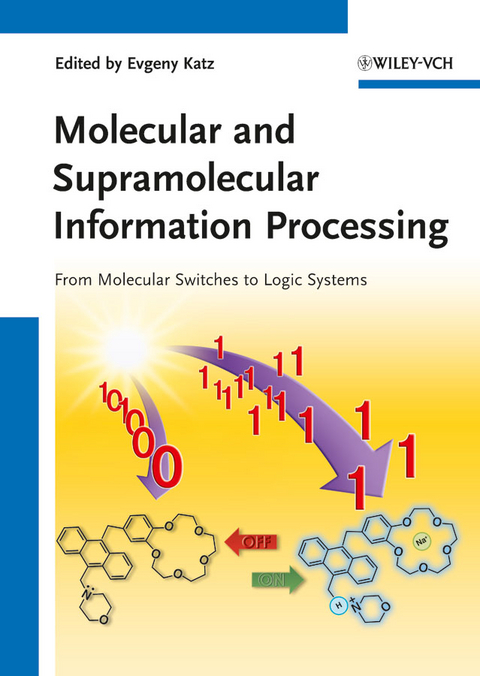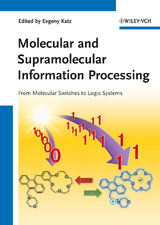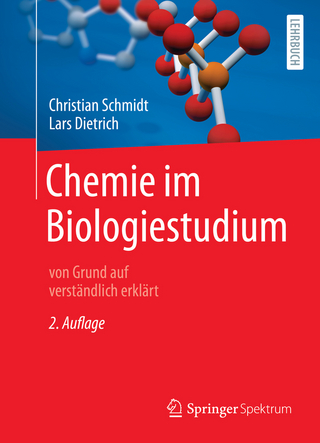Information Processing / Molecular and Supramolecular Information Processing
Wiley-VCH (Verlag)
978-3-527-33195-6 (ISBN)
- Titel ist leider vergriffen;
keine Neuauflage - Artikel merken
Evgeny Katz received his Ph.D. in Chemistry from Frumkin Institute of Electrochemistry (Moscow) in 1983. He was a senior researcher in the Institute of Photosynthesis (Pushchino), Russian Academy of Sciences (1983-1991), a Humboldt fellow at Technische Universität München (Germany) (1992-1993), and a research associate professor at the Hebrew University of Jerusalem (1993-2006). Since 2006 he is Milton Kerker Chaired Professor at the Department of Chemistry and Biomolecular Science, Clarkson University, NY (USA). He has (co)authored over 300 papers in the areas of biocomputing, bioelectronics, biosensors and biofuel cells (Hirsch-index 65). Professor Katz serves as Editor-in-Chief for IEEE Sensors Journal and a member of editorial boards of many other journals. On February 10, 2011, Thomson Reuters released data identifying the world's top 100 chemists over the past 10 years as ranked by the impact of their published research. Evgeny Katz was included in the list as #62 from approximately a million chemists indexed by Thomson Reuters.
Preface
MOLECULAR INFORMATION PROCESSING: FROM SINGLE MOLECULES TO SUPRAMOLECULAR SYSTEMS AND INTERFACES - FROM ALGORITHMS TO DEVICES
FROM SENSORS TO MOLECULAR LOGIC: A JOURNEY
Introduction
Designing Luminescent Switching Systems
Converting Sensing/Switching into Logic
Generalizing Logic
Expanding Logic
Utilizing Logic
Bringing in Physical Inputs
Summary and Outlook
BINARY LOGIC WITH SYNTHETIC MOLECULAR AND SUPRAMOLECULAR SPECIES
Introduction
Combinational Logic Gates and Circuits
Sequential Logic Circuits
Summary and Outlook
4 PHOTONICALLY SWITCHED MOLECULAR LOGIC DEVICES
Introduction
Photochromic Molecules
Photonic Control of Energy and Electron Transfer Reactions
Boolean Logic Gates
Advanced Logic Functions
Conclusion
ENGINEERING LUMINESCENT MOLECULES WITH SENSING AND LOGIC CAPABILITIES
Introduction
Engineering Luminescent Molecules
Logic Gates with the Same Modules in Different Arrangements
Consolidating AND Logic
"Lab-on-a-Molecule" Systems
Redox-Fluorescent Logic Gates
Summary and Perspectives
SUPRAMOLECULAR ASSEMBLIES FOR INFORMATION PROCESSING
Introduction
Recognition of Metal Ion Inputs by Crown Ethers
Hydrogen-Bonded Supramolecular Assemblies as Logic Devices
Molecular Logic Gates with [2]Pseudorotaxane-and [2]Rotaxane-Based Switches
Supramolecular Host-Guest Complexes with Cyclodextrins and Cucurbiturils
Summary
HYBRID SEMICONDUCTING MATERIALS: NEW PERSPECTIVES FOR MOLECULAR-SCALE INFORMATION PROCESSING
Introduction
Synthesis of Semiconducting Thin Layers and Nanoparticles
Electrochemical Deposition
Organic Semiconductors - toward Hybrid Organic/Inorganic Materials
Mechanisms of Photocurrent Switching Phenomena
Digital Devices Based on PEPS Effect
Concluding Remarks
TOWARD ARITHMETIC CIRCUITS IN SUBEXCITABLE CHEMICAL MEDIA
Awakening Gates in Chemical Media
Collision-Based Computing
Localizations in Subexcitable BZ Medium
BZ Vesicles
Interaction Between Wave Fragments
Universality and Polymorphism
Binary Adder
Regular and Irregular BZ Disc Networks
Memory Cells with BZ Discs
Conclusion
HIGH-CONCENTRATION CHEMICAL COMPUTING TECHNIQUES FOR SOLVING HARD-TO-SOLVE PROBLEMS, AND THEIR RELATION TO NUMERICAL OPTIMIZATION, NEURAL COMPUTING, REASONING UNDER UNCERTAINTY, AND FREEDOM OF CHOICE
What are Hard-To-Solve Problems and Why Solving Even One of Them is Important
How Chemical Computing Can Solve a Hard-To-Solve Problem of Propositional Satisfiability
The Resulting Method for Solving Hard Problems is Related to Numerical Optimization, Neural Computing, Reasoning under Uncertainty, and Freedom of Choice
ALL KINDS OF BEHAVIOR ARE POSSIBLE IN CHEMICAL KINETICS: A THEOREM AND ITS POTENTIAL APPLICATIONS TO CHEMICAL COMPUTING
Introduction
Main Result
Proof
KABBALISTIC-LEIBNIZIAN AUTOMATA FOR SIMULATING THE UNIVERSE
Introduction
Historical Background of Kabbalistic-Leibnizian Automata
Proof-Theoretic Cellular Automata
The Proof-Theoretic Cellular Automaton for Belousov-Zhabotinsky Reaction
The Proof-Theoretic Cellular Automaton for Dynamics of Plasmodium of Physarum polycephalum
Unconventional Computing as a Novel Paradigm in Natural Sciences
Conclusion
APPROACHES TO CONTROL OF NOISE IN CHEMICAL AND BIOCHEMICAL INFORMATION AND SIGNAL PROCESSING
Introduction
From Chemical Information-Processing Gates to Networks
Noise Handling at the Gate Level and Beyond
Optimization of AND Gates
Networking of Gates
Conclusions and Challenges
ELECTROCHEMISTRY, EMERGENT PATTERNS, AND INORGANIC INTELLIGENT RESPONSE
Introduction
Patten Formation in Complex Systems
Intelligent Response and Pattern Formation
Artificial Cognitive Materials
An Intelligent Electrochemical Platform
From Chemistry to Brain Dynamics
Final Remarks
ELECTRODE INTERFACES SWITCHABLE BY PHYSICAL AND CHEMICAL SIGNALS OPERATING AS A PLATFORM FOR INFORMATION PROCESSING
Introduction
Light-Switchable Modified Electrodes Based on Photoisomerizable Materials
Magnetoswitchable Electrodes Utilizing Functionalized Magnetic Nanoparticles or Nanowires
Potential-Switchable Modified Electrodes Based on Electrochemical Transformations of Functional Interfaces
Chemically/Biochemically Switchable Electrodes and Their Coupling with Biomolecular Computing Systems
Summary and Outlook
CONCLUSIONS AND PERSPECTIVES
Index
| Erscheint lt. Verlag | 9.7.2012 |
|---|---|
| Reihe/Serie | Information Processing |
| Verlagsort | Weinheim |
| Sprache | englisch |
| Maße | 170 x 240 mm |
| Gewicht | 850 g |
| Themenwelt | Naturwissenschaften ► Biologie ► Biochemie |
| Naturwissenschaften ► Chemie ► Organische Chemie | |
| Technik ► Maschinenbau | |
| Schlagworte | Biomolecules (DNA, RNA, Peptides, etc.) • Biomolekül • Biomoleküle (DNA, RNA, Peptide) • Chemie • Chemistry • Electronic materials • Elektronische Materialien • Materials Science • Materialwissenschaften • Nanochemie • nanochemistry • Nanotechnologie • nanotechnology • Sensor • Sensoren • Sensor Materials |
| ISBN-10 | 3-527-33195-6 / 3527331956 |
| ISBN-13 | 978-3-527-33195-6 / 9783527331956 |
| Zustand | Neuware |
| Haben Sie eine Frage zum Produkt? |
aus dem Bereich




